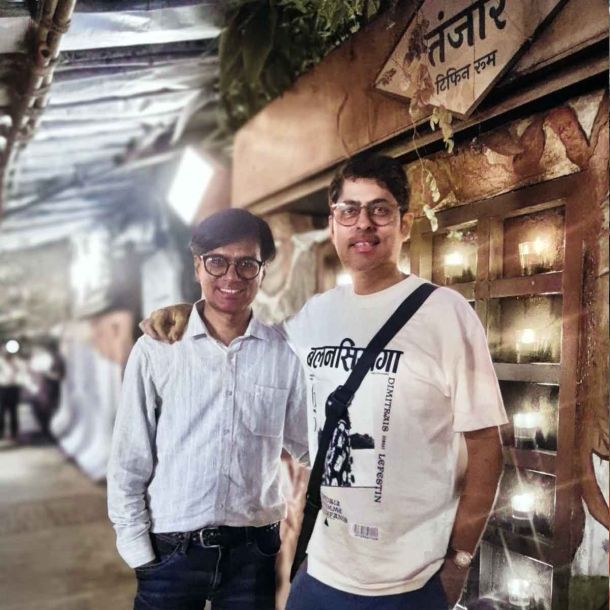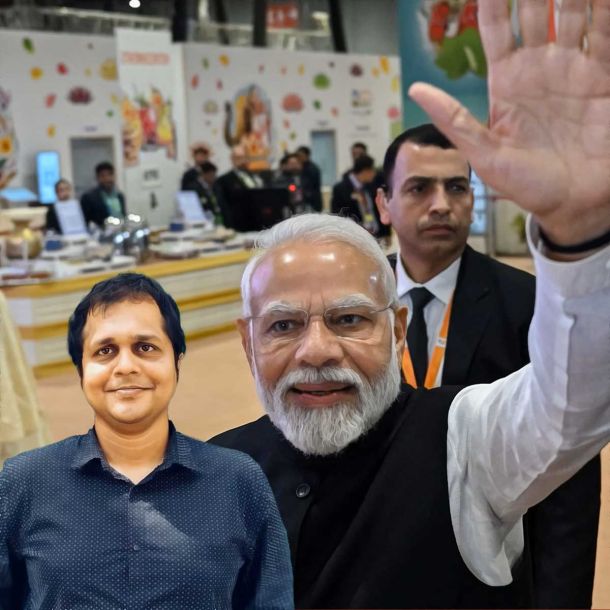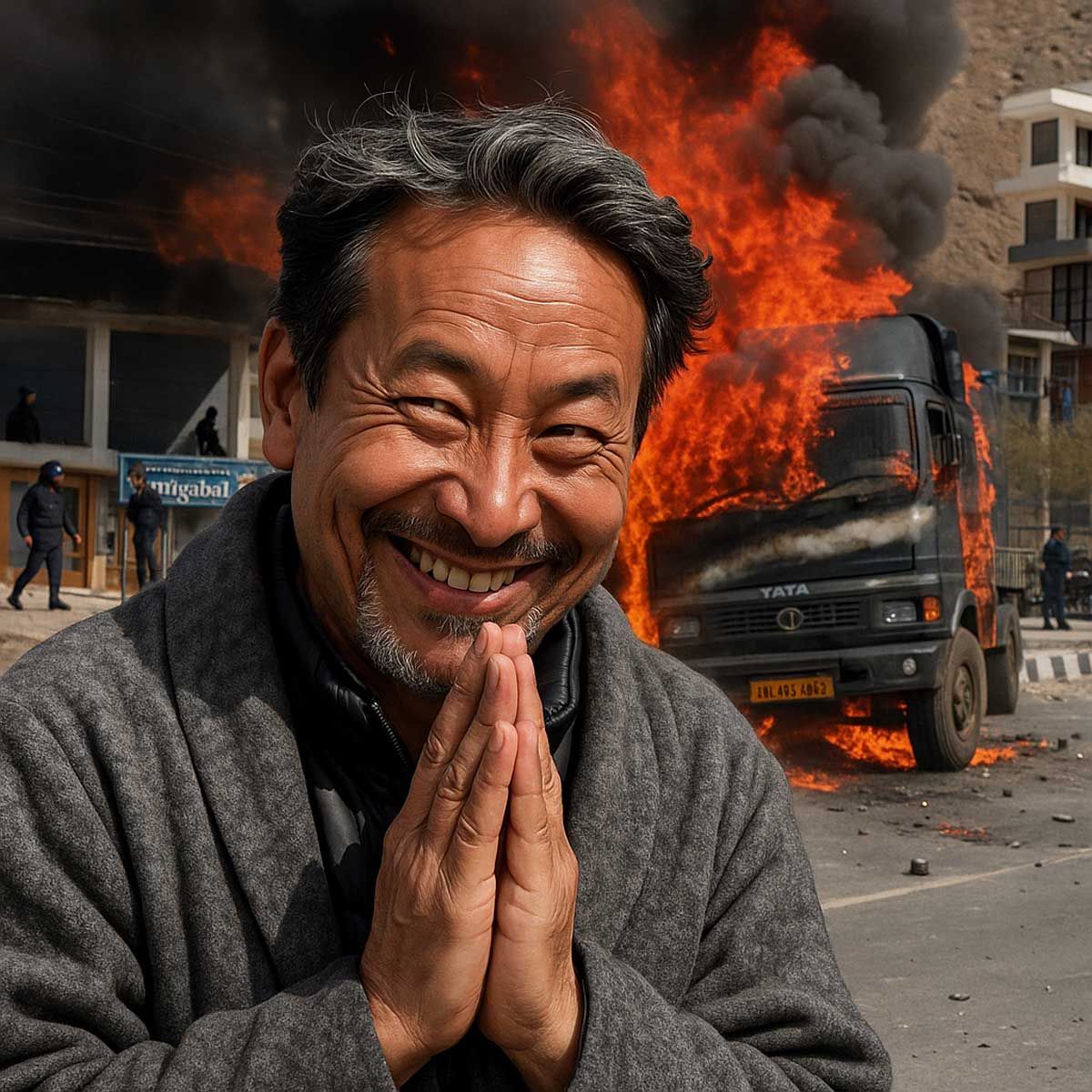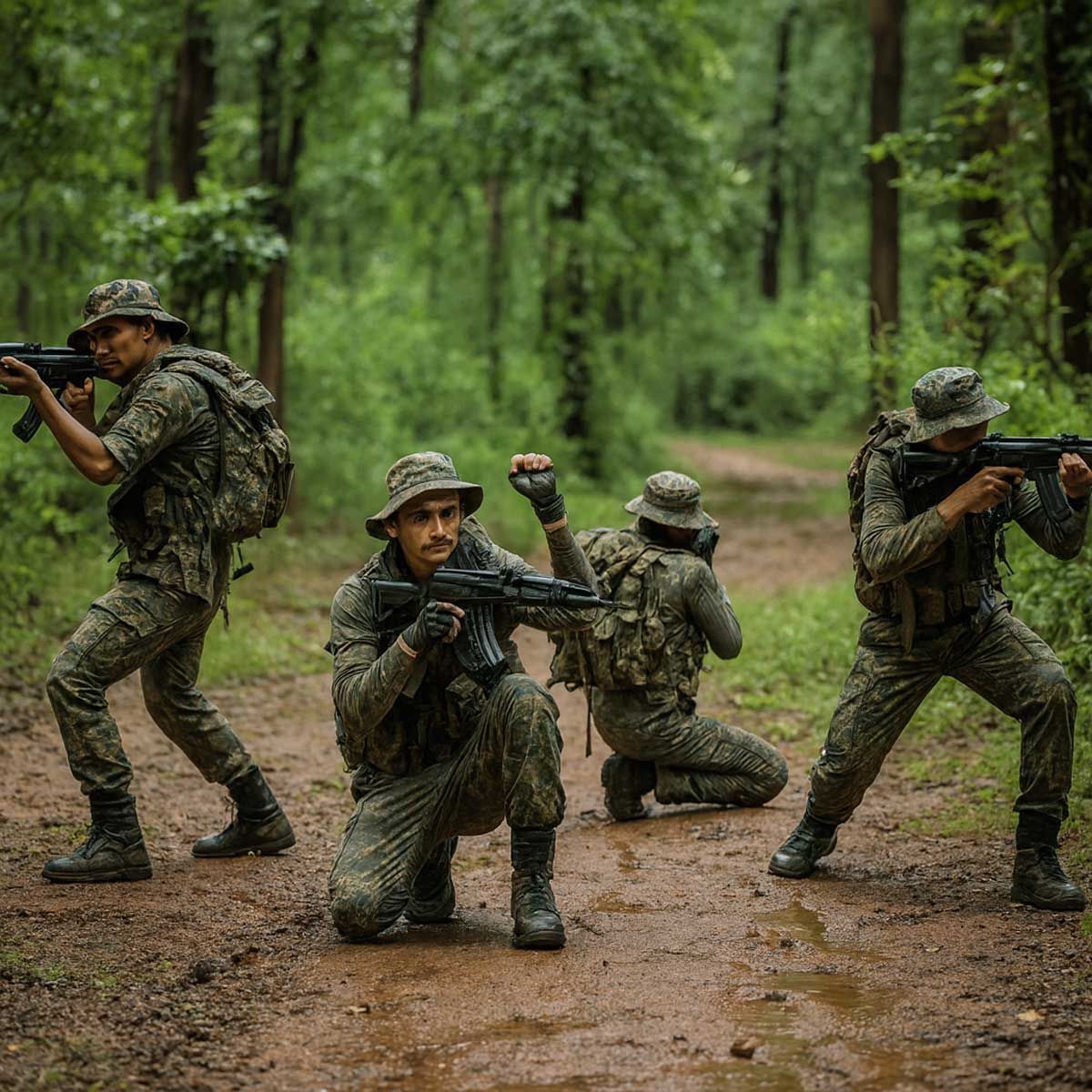More Coverage
Twitter Coverage
Satyaagrah
Written on
Satyaagrah
Written on
Satyaagrah
Written on
Satyaagrah
Written on
Satyaagrah
Written on
JOIN SATYAAGRAH SOCIAL MEDIA
Captivating world of Warli art - an ancient tribal tradition of the organic colors, rich cultural heritage, and mesmerizing techniques from Mumbai that have preserved this unique folk art through generations, the timeless beauty with soaring global appeal

India is a land, rich with art, tradition and culture. Most people, especially those living in the rural sector of India, practically make a livelihood by practicing various forms of arts and crafts. Warli art is an ancient Indian folk art tradition of painting of a Maharashtrian tribe called Warli. Warli is the name of the biggest tribe found on the northern outskirts of Mumbai. The village painters express their skill through natural colours and geometrical hand painting with wooden stick.
The warli painting essentially depicts the basic principle of life which are used to depict human figures, animal’s figures, houses etc. Warli art is known for its monochromatic depictions that express the folk life of socio-religious customs, imaginations & believes. ‘White colour’ is used on a red earthen background.
|
Historians believe that the warli tradition can be traced back to as far as the Neolithic period between 2,500, BC to 3,000 BC. It has since; travelled across borders & territories & home décor products with warli painting have an international appeal & demand too. The warli painting was discovered by the world as late as the seventh decade of the last century. This art form is simple in comparison to the vibrant paintings from Madhubani. Warli painting is an indigenous art of Maharashtra.
The word ‘’Warli’’ come from the word ‘Warla’ which means the piece of land. This art has received popularity at national and international level because of its simplicity in shapes, use of single white colour, requirement of minimum tools and creation of beautiful motifs by using simply lines, triangles, squares, circles and dots. Warli tribe resides near base of ranges of sahyadri mouintains spreaded at northern side of Mumbai viz. Javhar, Dahanu, Talasari, Mokhada, Wada, Palghar village. They build their square bamboo huts coated with mud and cowdung and these mud walls are painted at the time of ritual functions and marriage ceremony.
Warli tribe is fond of folk art and they worship god, goddess and ritual culture too. They depict their traditional lifestyle and their customs and traditions through this art of painting. Women are mainly engaged in the creation of these paintings. Warli art is known for its monochromatic depictions that express the folk life of socio-religious customs, imaginations & believes. Warli Tribe has still preserved their independent existence through Warli art and folk dance “Tarpa Nrutya”. Earlier Warli painting used to be etched out on walls of Warli’s houses, but nowadays they are being painted on papers, vases, mugs, bed sheets, textiles and apparels too. The wall paintings done only for special occasions such as weddings or harvests.
These painting do not depict social life. Images of human beings & animals, along with scenes from daily life are created in a loose rhythmic pattern. Nested at the foot of the western ghat range in Maharashtra, India is the settlement of an ancient tribe known as the warli’s. These tribal people, who survive on forest produce & worship nature, have carved an international niche for themselves by virtue of their artistry. The name of the clan has given the name to the art form & today we know it as the warli painting. Artist & scholars believe the painting style.
Warli Art and Warli paintingare tribal art done majorly by the Adivasi community located in North Sahyadri Range in western India. The Warli community is the largest tribe located on the outskirts of Mumbai. Despite its close proximity to Mumbai, the Warli tribesmans have been able to shun most influences caused by urbanisation. The art-form was first discovered in the early seventies. According to Yashodhara Dalmia, “when Warli painting was first discovered in the early 1970s, it created a huge sensation in many aspects because these paintings were very unique to that of other folk paintings in India.”
Warli as we know it today was introduced due to the efforts of late Bhaskar Kulkarni. He encouraged the Warli artists to paint their art on paper instead of the mud walls of their huts. The monotony of Warli being a married women-wall art tradition was broken by Jivya Soma Mashe. He experimented with non-ritual paintings and created new images depicting everyday life.
Their extremely rudimentary wall paintings use a very basic graphic vocabulary: a circle, a triangle and a square. Their paintings were monosyllabic. The circle and triangle come from their observation of nature, the circle representing the sun and the moon, the triangle derived from mountains and pointed trees. Only the square seems to obey a different logic and seems to be a human invention, indicating a sacred enclosure or a piece of land.
In this article, we shall cover various aspects of Warli art covering the themes, concepts, traditional aspects, colour theory and preparation for a Warli painting.
|
Warli art and warli paintings have a rich and ancient history. These paintings most resemble prehistoric cave paintings and their origins have been dated back to 2500 to 3000 BCE, as stated in Yashodhara Dalmia’s book “Painted World of the Warli”. The visual resemblance to these cave paintings further adds value to it being prehistoric paintings. Warli art as an art-form is extremely well-preserved and has been imbibed into the tribal communities and passed from generation to generation.
A majority of the warli tribes are known to reside near the base of the Sahyadri mountains spread across the northern side of Mumbai viz. Javhar, Dahanu, Talasari, Mokhada, Wada and Palghar villages. The art has received immense popularity at both international and national platforms because of its simplicity in shapes, use of single white colour, requirement of minimum tools and creation of beautiful motifs by using simple lines, triangles, squares, circles and dots.
In late 1970s, artistJivya Soma Mashestarted practising Warli art. Born in 1934 in the Thane district of Maharashtra, Jivya Soma took up Warli, a predominantly ritual art and radically changed it from ut begin used for special occasions to being used on a daily basis. His work was recognised nationally and internationally with political figures such as Jawaharlal Nehru and Indira Gandhi and by centres such as Magiciens de la terre, Centre Pompidou. Jivya was able to showcase a “heightened sensitivity and unusually powerful imagination” which were the highlight of his earlier introspective work.
He moved Warli art and warli paintings from the constraints of rough, sheer walls onto paper and canvas. The move allowed freedom of expression helping him create warli art paintings that were free and highly sensitive in nature. His sensitivity emerges in every detail of his paintings. Strokes, lines and a mass of dots swarm and vibrate on the canvas, coming together to form clever compositions. Details and the overall composition both contribute to creating a sense of life and movement. Recurring themes, from tribal life and Warli legends, also form a part of celebrating life and movement.
Jivya Soma Mashe summed up the deep feeling which animates the Warli people, saying "There are human beings, birds, animals, insects, and so on. Everything moves, day and night. Life is movement".
He received the Padma Shri award for his contribution towards Warli painting. He introduced Warli to the world as an art form and inspired many tribal youth to practice Warli as commercial art. He died aged 84 on 14 May 2018 and was accorded a state funeral.
Connection with Mother Nature
Warli art is a fascinating form of art that's deeply rooted in the reverence for Mother Nature. This art form, named after the Warli tribe that originated it, is centered around the appreciation and representation of natural elements, reflecting the tribe's deep-seated relationship with the environment. Farming is the main livelihood for the Warli tribe, which infuses in them a profound respect for the earth and the bountiful resources it offers, including nature and wildlife. This respect is beautifully reflected in their art.
The Warli artists, with an eye for the aesthetic, make use of their humble clay huts as the canvas for their artwork, just as prehistoric humans did when they made their first cave paintings. This distinctive feature of Warli art ties it back to the earliest expressions of human creativity, making it a unique link to our past. But these are not just paintings for decoration. They represent something much more profound: the belief in nature as a divine entity.
In Warli paintings, there's a conscious and deliberate avoidance of religious iconography, such as gods and religious symbols. Instead, these works of art make nature the focal point, embodying the belief in its divine essence and showcasing the intrinsic human connection and dependency on nature.
Warli paintings also celebrate community spirit and illustrate unity among people. These works feature scenes from everyday life, displaying a harmonious social environment where everyone is connected. Elements like trees, animals, and humans are drawn from real-life scenarios and situations. Whether it's a local event, a social gathering, or even formations of humans, everything is depicted in a simple yet striking manner.
What's more, a Warli painting can be a visual storyteller, narrating traditional tales and stories passed down through generations. But even as they maintain this link to their past, Warli artists aren't averse to innovation. In an example of adapting to changing times, contemporary artists have begun incorporating elements of modern life such as bicycles, cars, buildings, computers, planes, and trains into their works.
|
Now, let's delve a little deeper into the style and symbols in Warli art. These seemingly basic artworks are crafted using three basic geometric shapes: the circle, the triangle, and the square. But what might appear simple at first glance is laden with meaning. Each shape symbolizes different elements found in nature:
- The circle represents celestial bodies like the sun and the moon.
- The triangle is a symbol for natural features like mountains and pointed trees.
- The square, a human invention, signifies a sacred enclosure or a piece of land.
Each Warli painting is centered around a primary motif, often enclosed within a square, known as the "chauk" or "chaukat". These symbols convey various aspects of Warli life and culture. Male gods, which are not common in Warli art, are usually shown as spirits who have taken on human forms.
The central motif is often surrounded by scenes from everyday life, depicting activities like hunting, fishing, and farming. Festivals, folk dances, and other communal activities are also popular themes in Warli art. The human and animal figures in these paintings are creatively represented by two inverted triangles joined at their tips. The upper triangle represents the torso, while the lower triangle represents the pelvis. This delicate balance symbolizes the harmony and equilibrium of the universe.
Warli paintings are not limited to just ritualistic depictions. They also beautifully capture the daily routines and activities of village members, offering a glimpse into their everyday lives. A Warli painting is more than just a work of art; it's an emblematic expression of daily experiences, beliefs, and traditions.
The Warli painting style, while simple, is rich with symbolic elements that collectively narrate the Warli way of life. Key characteristics of Warli paintings include:
- The use of natural and synthetic white colour which stands out against the earthen backgrounds.
- A border made up of basic geometric figures like triangles and squares.
- Symbols like the sun, moon, birds, and trees which support the main theme.
- Abstract human figures, figures of a newly married couple, and in some cases, figures of deities.
- The faces of human figures are depicted as circles, while the body is represented by two triangles. Males are identified by a larger upper triangle, while a female is identified by a wider lower triangle. Females can also be identified by curved lines representing a ponytail.
It's essential to understand the motifs used in Warli paintings as they help us recognize the type of painting we're viewing. Warli paintings can be broadly divided into two categories: ritualistic and non-ritualistic.
Ritualistic paintings are sacred, connecting the past, present, and future. They are often tied to specific rituals or ceremonies such as Lagna Chowk, Dev Chowk, Kanna, etc. These paintings play an essential role in the tribe's cultural and spiritual practices.
Non-ritualistic paintings, on the other hand, aren't linked to any specific ritual or ceremony. They are typically created for aesthetic or decorative purposes and feature various themes like hunting scenes, agricultural activities, festival scenes like Holi, and many more.
There are a number of commonly seen motifs in Warli art. These include:
Marriage Ceremony | One of the most cherished and meaningful Warli paintings is the Marriage Ceremony painting. This painting holds a unique significance as it is done by a 'suvasini', a woman who is married. The primary element in this painting is the marriage 'chowk', or square, drawn on the wall. The rich traditions of a Warli wedding, which usually extends over four to five days, come alive in this artwork with various rituals beautifully depicted.
|
The purpose of these 'chowks' is multi-fold: they are believed to safeguard the newlyweds from malevolent spirits, bestow fertility upon the couple, and enhance their procreative capabilities. There are two distinct kinds of marriage chowk in Warli painting, the Dev Chowk and the Lagan Chowk.
Lagna Chowk | This rectangle houses the figure of Palaghat Devi, the goddess of fertility, who is invoked to shower the newlyweds with prosperity and good fortune. The border of this rectangle is decorated with an array of diverse geometric patterns, adding a visual charm to the painting.
Several interpretations of Palaghat Devi can be found in different parts of the painting, and the same motif is also painted in both the bride's and groom's houses. An ordinary 'chowk' might have five to eight rows of designs like pophala, sakhali, dhak, pasondi, and the basinda pattern. Warli artists perceive the lagan chowk as the goddess's jewelry, which explains why it is painted with such intricate designs and geometric patterns.
Dev Chowk | This is created at the time of the wedding, usually positioned adjacent to the Lagan Chowk. The key figures here include a 'panchsiriya', or a five-headed god, and a headless warrior, either standing or astride a horse. This depiction serves to shield the bride and groom from disease, illness, misfortune, and ill luck.
Human Figures | Warli paintings often have a central motif encircled by scenes of hunting, fishing, and farming. In this unique art form, human figures are represented by two triangles joined at the tip: the upper triangle symbolizes the torso, while the lower one denotes the pelvis. The face is represented by a circle, bereft of any detailed features like a nose, eyes, or ears. Men are distinguished by their hairstyle while women are identified by a unique hair bun represented in a circle, called an "Ambada".
Birds and Animals | Warli artists, who are predominantly farmers, draw heavily from the surrounding environment for their art. Thus, their paintings often feature domestic animals such as cows, bulls, roosters, hens, sheep, and dogs. Birds, including peacocks and sparrows, also find a place in Warli art.
The peacock, a regal and majestic bird, has been a traditional motif in textiles, embroidery, and paintings. In addition to these, snakes and frogs are frequently depicted in Warli paintings. The frog, specifically, is seen as a symbol of rainfall and is often included in scenes of harvesting or farming to represent abundant grain yield and prosperity.
Tarpa Dance | The Tarpa Dance is a recurring theme in many Warli paintings, and it holds a central place in Warli culture. The Tarpa is a trumpet-like instrument crafted from dried bottle gourds, bamboo tubes, stickers, cord, and wax. As the tarpa player begins his tune, the villagers, both men and women, interlock hands and form a circle around him.
The dancers follow the tarpa player, moving and turning as he does, careful not to turn their backs on him. The musicians play different types of notes to guide the lead dancer in either a clockwise or counter-clockwise direction. The dancers will occasionally venture into the audience, encircling them as a form of entertainment. This circular formation of dancers is also seen as symbolic of the circle of life.
Kanna | The Kanna is a unique Warli image, drawn only on the ground by the 'Suvasinis'. It is considered a symbol of virginity and is drawn on the third day of the wedding at the bride's house. This image is created around the pounding hole in their houses, which is typically used to separate seeds from their husks.
The Kanna is drawn using several colours: white from rice powder, yellow from turmeric, red from Kumkum, and orange from sindoor. It symbolizes the virginity of a Warli bride, representing the vulva of a virgin Warli bride.
Muthi | The 'Muthi' or the fist imprint is a common sight on the walls of Warli huts when new rice is brought home from the fields. This symbol can be found almost everywhere in the tribal dwellings, including the granaries, inner kitchen walls, ploughs, and even on the baskets used for storing grain. The repeated use of this imprint represents an abundance of food and is a symbol of the tribe's agricultural wealth and prosperity.
Role of Warli Artisans
A Warli painting is an extraordinary work of art, representing the confluence of a myriad of elements that collectively give rise to a remarkable end result. Each element involved in the process of creating a Warli painting has a significant role, and together they form the mesmerizing mosaic of this age-old folk art. Let's delve deeper into the world of Warli painting, exploring each component in a simplified and exciting manner.
Sourcing the Raw Materials Warli paintings find their origins in the simplest of homes, where these beautiful works of art were painted on the mud walls. Traditionally, Warli artists did not trace their designs but rather created them spontaneously and directly on the chosen canvas, which is the wall of a house in most cases. Wooden sticks were their paint brushes, and the backdrop for these unique designs often held an earthy, reddish hue. To achieve this warm background, the artists would coat the house walls with cow dung and then apply a layer of Geru powder. The use of cow dung may seem unconventional to some, but it's one of the many traditions that make Warli art truly unique. The white paste utilized for the designs is made from rice flour mixed with water, forming a natural and easily accessible paint.
Using Colours The creation of Warli paintings involves the use of organic and natural colours. The walls used for these paintings are made from a mix of branches, earth, and cow dung, which provides a red ochre background, setting the perfect stage for the artists' designs. The simplicity of the Warli art is highlighted by its exclusive use of white paint for drawing, the formulation of which involves a mixture of rice paste and water, with gum serving as a binder. The artists extract natural dyes from various sources to create different shades of Geru. For instance, turmeric, Kumkum leaves, and coloured flowers are used for extraction. Charcoal provides the black colour, symbolizing evil spirits, while Butea Monosperma (Palas) flowers yield a red colour, used to signify the existence of god Narada Muni and departed souls. The prosperity is depicted with the use of Kumkum, and yellow colour, signifying vibrancy and positivity, is obtained from pineapples.
Employing Painting Techniques The painting process begins with deciding on the design. Without resorting to tracing, the artists directly draw the design on their chosen canvas, be it cloth, paper, or wall. The tools are as natural as the art itself; bamboo sticks are chewed at one end to make them as supple as a paintbrush. The motifs are painted with the white paint onto the respective canvas, which could range from walls, earthen pots, and wooden articles to paper or cloth. The human figures in the painting are uniquely crafted by connecting two triangles at their tips. The hands and legs are usually represented in various dancing positions, adding to the vibrant cultural representation. The rest of the design is brought to life by painting minute details, and to keep the colour intact, the cloth is ironed on the reverse side.
Warli art, since its beginning, has continually evolved, with a majority of modern-day artists experimenting with watercolours and handmade paper or canvas cloth. However, the true essence of Warli art remains intact even with these modern adaptations. To provide a source of income beyond agriculture, many organizations encourage Warli artists to create their traditional paintings on handmade paper for commercial sales. This initiative has brought a surge in Warli art’s popularity among national and international communities, cementing its place in the global art scene.
Warli art, a revered tradition of the Maharashtrian Warli tribe, beautifully encapsulates their cultural ethos, customs, and traditions. These paintings are typically done on the mud walls of square bamboo huts, which are coated with a mixture of mud and cow dung. The women of the tribe usually create these art pieces, which not only depict their lifestyle but also illustrate their worship for gods, goddesses, and ritualistic culture. These artistic expressions have allowed the Warli tribe to preserve their unique identity through their artwork and the traditional “Tarpa Nrutya” folk dance.
The evolution of Warli art has transcended the confines of traditional mud walls and ventured into various mediums like canvas and paper, becoming an elegant adornment for home decorations. It adorns the walls of flats, the Diwankhana of bungalows, and even the lobbies of five-star hotels. The art form also finds a place on everyday items like coffee mugs, files, wall hangings, and paperweights. One of the significant diversifications of Warli art is its entrance into the textile world. The simple and aesthetic appeal of Warli art paintings on apparel like dresses, kurtis, sarees, and dupattas have gained immense popularity.
Warli paintings, having started as a simple tribal art, have now gained recognition as a sophisticated art form. From high-end paintings sold at exorbitant prices to being a prevalent print in fashion and home décor, Warli art has significantly broadened its reach. Not just on designer sarees and silk cushion covers, but even on mobile covers, purses, and jewelry, Warli art has found a place, further increasing its customer base.
A recent innovation in Warli art is the incorporation of modern urban motifs like bicycles, auto rickshaws, and roads, striking a chord with a more contemporary audience. However, amidst these changes and advancements, Warli artists have ensured that the tradition's originality and essence remain undiluted.
Now, let's explore some interesting facts about Warli art. Firstly, Warli prints and paintings are generally not used on any footwear, as it's considered an auspicious art form by the tribes. Secondly, even though traditionally this art was exclusively done by women, with commercialization and greater demand, male artists have now started to engage in creating Warli art.
Lastly, the Warli tribe holds the cultural intellectual property right of Warli painting, and they have set up a not-for-profit company called 'Adivasi Yuva Seva Sangh' to protect the Warli art form and their intellectual property rights. This move has empowered the Warli artists, allowing them to earn fair wages and recognition for their work and to preserve their rich cultural heritage for future generations.
In conclusion, Warli art is a rich tradition, passed down from generation to generation, and is a beautiful reflection of the Warli tribe's lifestyle and culture. Despite its evolution and increasing commercialization, it has maintained its essence and continues to be a unique art form admired around the world.
 Support Us
Support Us
Satyagraha was born from the heart of our land, with an undying aim to unveil the true essence of Bharat. It seeks to illuminate the hidden tales of our valiant freedom fighters and the rich chronicles that haven't yet sung their complete melody in the mainstream.
While platforms like NDTV and 'The Wire' effortlessly garner funds under the banner of safeguarding democracy, we at Satyagraha walk a different path. Our strength and resonance come from you. In this journey to weave a stronger Bharat, every little contribution amplifies our voice. Let's come together, contribute as you can, and champion the true spirit of our nation.
 |  |  |
| ICICI Bank of Satyaagrah | Razorpay Bank of Satyaagrah | PayPal Bank of Satyaagrah - For International Payments |
If all above doesn't work, then try the LINK below:
Please share the article on other platforms
DISCLAIMER: The author is solely responsible for the views expressed in this article. The author carries the responsibility for citing and/or licensing of images utilized within the text. The website also frequently uses non-commercial images for representational purposes only in line with the article. We are not responsible for the authenticity of such images. If some images have a copyright issue, we request the person/entity to contact us at This email address is being protected from spambots. You need JavaScript enabled to view it. and we will take the necessary actions to resolve the issue.
Related Articles
- "Toys: Childhood's magic": In a spirited resurgence, the Central Government champions the 400-year-old legacy of Kondapalli toys, fostering a golden era where Aryakhastriyas artisans breathe life into vibrant, ethereal art with rejuvenated zest and unity
- An Artisan Heritage Crafts Village: Indigenous Sustainability of Raghurajpur
- "In every brushstroke, a story unfolds": Amadubi, a vibrant canvas where nature's colors meet tribal artistry, earthy hues tell tales of ages, and every handcrafted piece echoes generations of tradition, dive into this treasure to feel the pulse of Bharat
- "When heritage is stolen, a piece of history is lost forever": 16th c. Shri Lakshmi of Kerala lies as gift of Harry Lenart in Los Angeles County Museum of Art, a melancholy note that such priceless treasures of Indian heritage rest in foreign land
- Hindus need temples today more than ever and here is why
- "Every relic of the past is a link to the echoes of history": Unearthing a 2,300-year-old elephant statue in Odisha's Puri, opens a time portal to Emperor Ashoka's era, illuminating the influence of Buddhism and its profound symbolism in ancient India
- History books should teach India’s civilisational, linguistic heritage, not unfounded claims: Parliamentary Committee meets to discuss NCERT books
- Our first true war of independence lie forgotten within the fog of time and tomes of propaganda: Sanyasi Rebellion, when "renouncers of the material world" lead peasants in revolt against British and fundamentalist islamic clans
- PM Narendra Modi inaugurated the Statue of Equality of Sri Ramanujacharya and emphasized 'Progressiveness does not mean detaching from one’s roots and that there is no conflict between progressiveness and antiquity.'
- Teetering on the edge of extinction due to synthetic and power looms sarees, Karnataka Udupi sarees, rooted in a 4,500-year-old weaving tradition, are now being revitalized thanks to NGOs' training programs and the Geographical Indication tag application
- The Calculated Destruction of Indian Gurukuls (Education System) by British Raj which resulted in the tormented Indian Spirit
- Dangers of losing our identity: Guru Tegh Bahadur forgotten and Aurangzeb being glorified
- BHU starts India's first Hindu Studies course with topics on ancient warfare, military strategy, women in military
- RTI reply revealed that keys to the treasure room 'Ratna Bhandar' of Puri Jagannath temple which has a lot of gold, silver, and precious jewels donated by devotees and kings over the centuries have been ‘missing’ since 1970: Odisha
- NCERT turns woke with sex-interested contributor Vikramaditya Sahai pushing gender jargon on children: How LGBT activists are calling legitimate criticism of a public figure ‘transphobia’




























